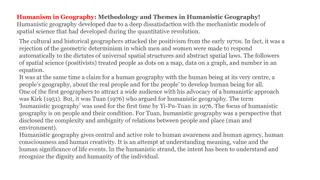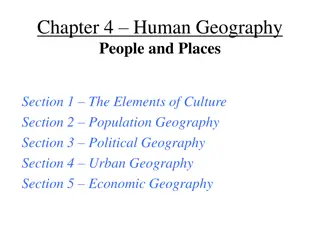Human Adaptations to Diverse Environments: A Study in Environmental Geography
Humans exhibit various biological and behavioral adaptations to thrive in different environments, showcasing our ability to modify and adapt to diverse ecosystems. This adaptation is essential for our survival in varied habitats, ranging from humid tropical forests to arctic wastelands. Through genetic and physiological adjustments, humans can deal with environmental stresses and challenges, enabling our species to thrive in a wide range of settings.
Download Presentation

Please find below an Image/Link to download the presentation.
The content on the website is provided AS IS for your information and personal use only. It may not be sold, licensed, or shared on other websites without obtaining consent from the author. Download presentation by click this link. If you encounter any issues during the download, it is possible that the publisher has removed the file from their server.
E N D
Presentation Transcript
B.A 4thsemester Paper-4016 Environmental geography and disaster management
Human environment relationship:Adaptation in different Biomes Humans exhibit a number of biological adaptations to the great variety of environments they occupy Because of the fact that humans live in a greater variety of habitats than any other species, it is natural to ask how humans adapt to these varied environments. Human adaptation involves both biological and behavioral mechanisms. Human behavioral ability to modify the environment is the major factor that has allowed us to occupy the diverse ecosystems that we do. In fact, many of the biological adaptations that we see in humans are adaptations to environmental conditions we ourselves have produced.
The term adaptation can be used in many different ways, but here it is used in its most general sense: adaptations are beneficial adjustments to the environment. A crucial aspect of the concept of adaptation is that an adaptation must convey some overall benefit. There are several methods for determining human biological adaptations to the physical environment. One is to look for global patterns of human variation that correlate with some aspect of the physical environment, such as temperature or solar radiation. If there is a strong relationship between the pattern of variation in the biological characteristic and the environmental variable, then this is evidence that the environmental factor may be the cause of the biological variation. The best evidence for genetic adaptation to climate on a global scale is the case of skin color as an adaptation that evolved as a result of selection due to ultraviolet radiation.
There are global patterns of variation in body size and shape as well, but these are less pronounced than for skin color, and it is not always clear to what extent body size variation represents adaptation to climatic stress. Another approach is to compare populations in terms of how they deal with climatic extremes. Such studies indicate that humans are basically a heat-adapted species, and there is little evidence for variation among populations in their biological ability to deal with heat stress. On the other hand, we are not biologically well adapted to deal with extreme cold. Because not all human populations share a history of exposure to cold climates, we do see evidence for variation among populations in ability to deal biologically with extreme cold.
When traveling to high altitudes, our bodies adjust so that our cells still receive sufficient oxygen We also are constantly responding in physiological ways to internal and external stresses such as bacterial and viral infections, air and water pollution, dietary imbalance, and overcrowding. This ability to rapidly adapt to varying environmental conditions has made it possible for us to survive in most regions of the world We live successfully in humid tropical forests, harsh deserts, arctic wastelands, and even densely populated cities with considerable amounts of pollution. Most other animal and plant species are restricted to one or relatively few environments by their more limited adaptability. The human body readily responds to changing environmental stresses in a variety of cultural ways also.
Over the last half million years at least, we invented technological aids that allowed us to occupy new environments without having to first evolve biological adaptations to them. Houses, clothing, and fire permitted us to live in temperate and, ultimately, arctic regions despite the fact we still essentially have the bodies of tropical animals.

























